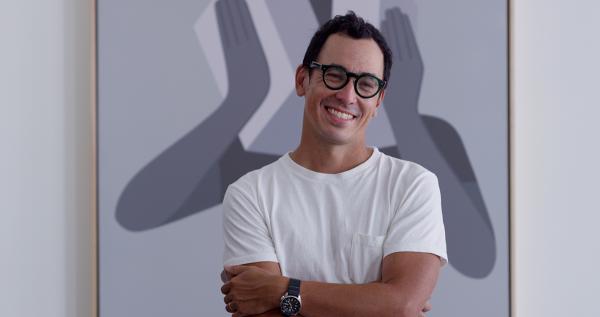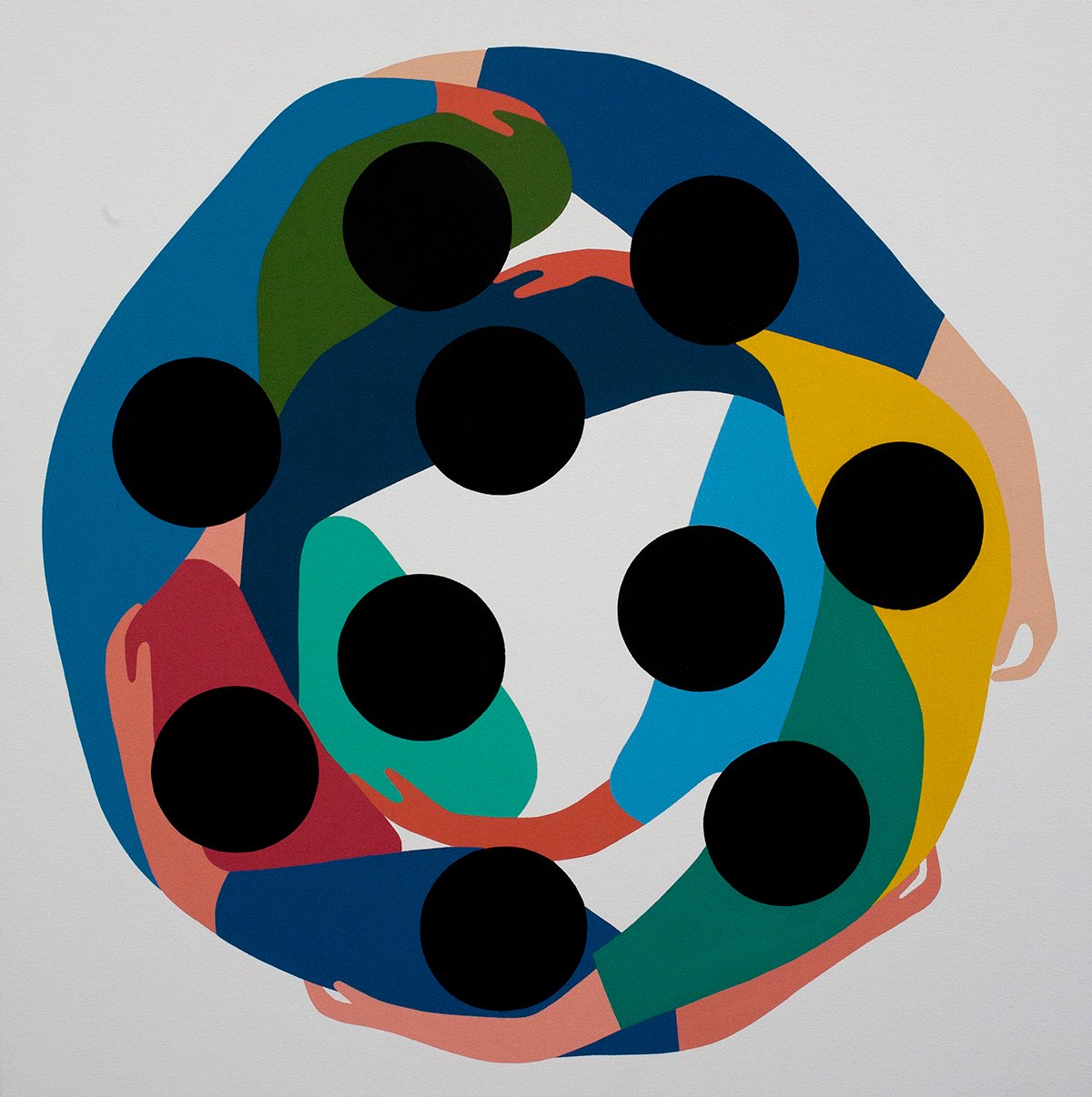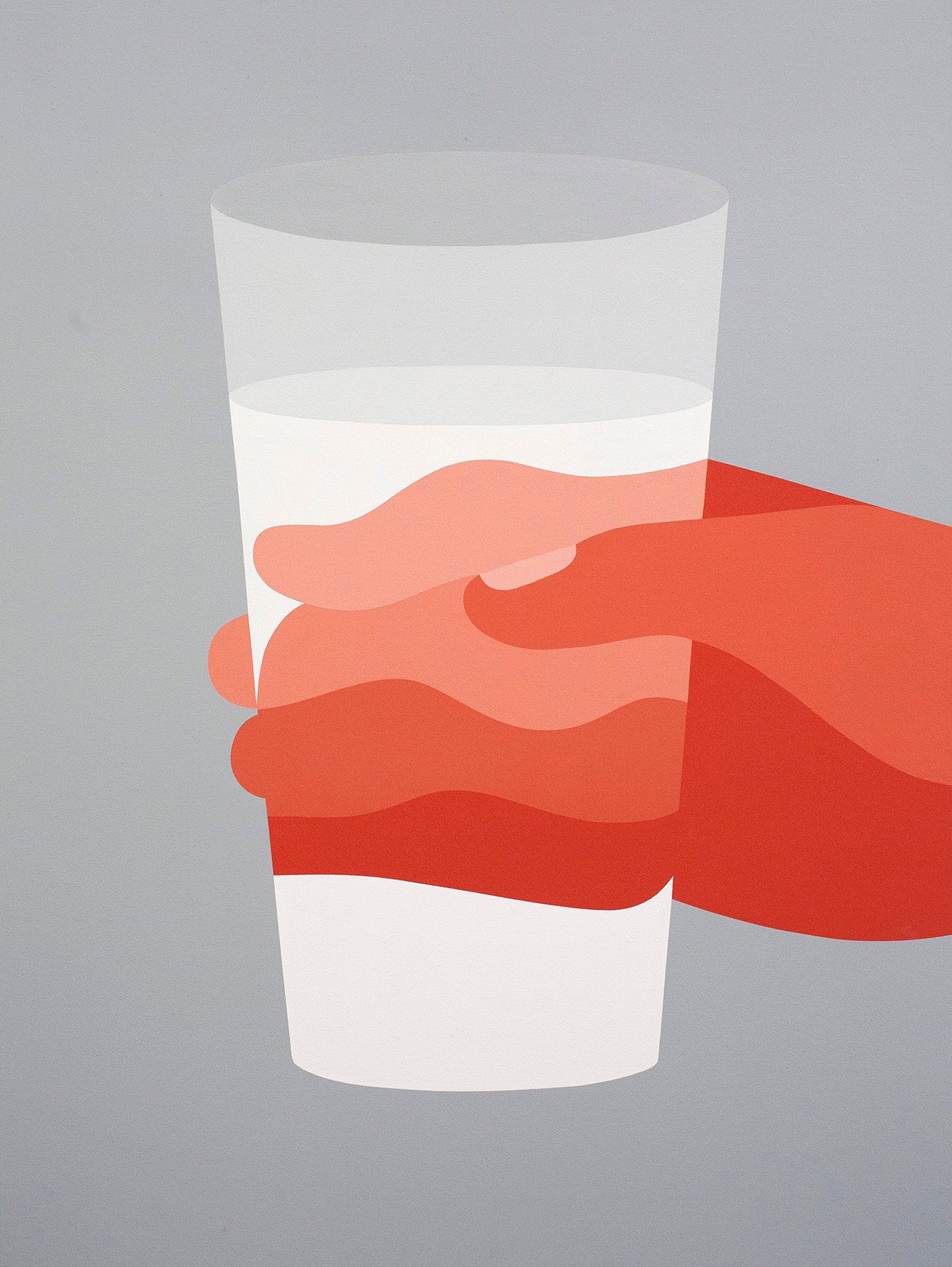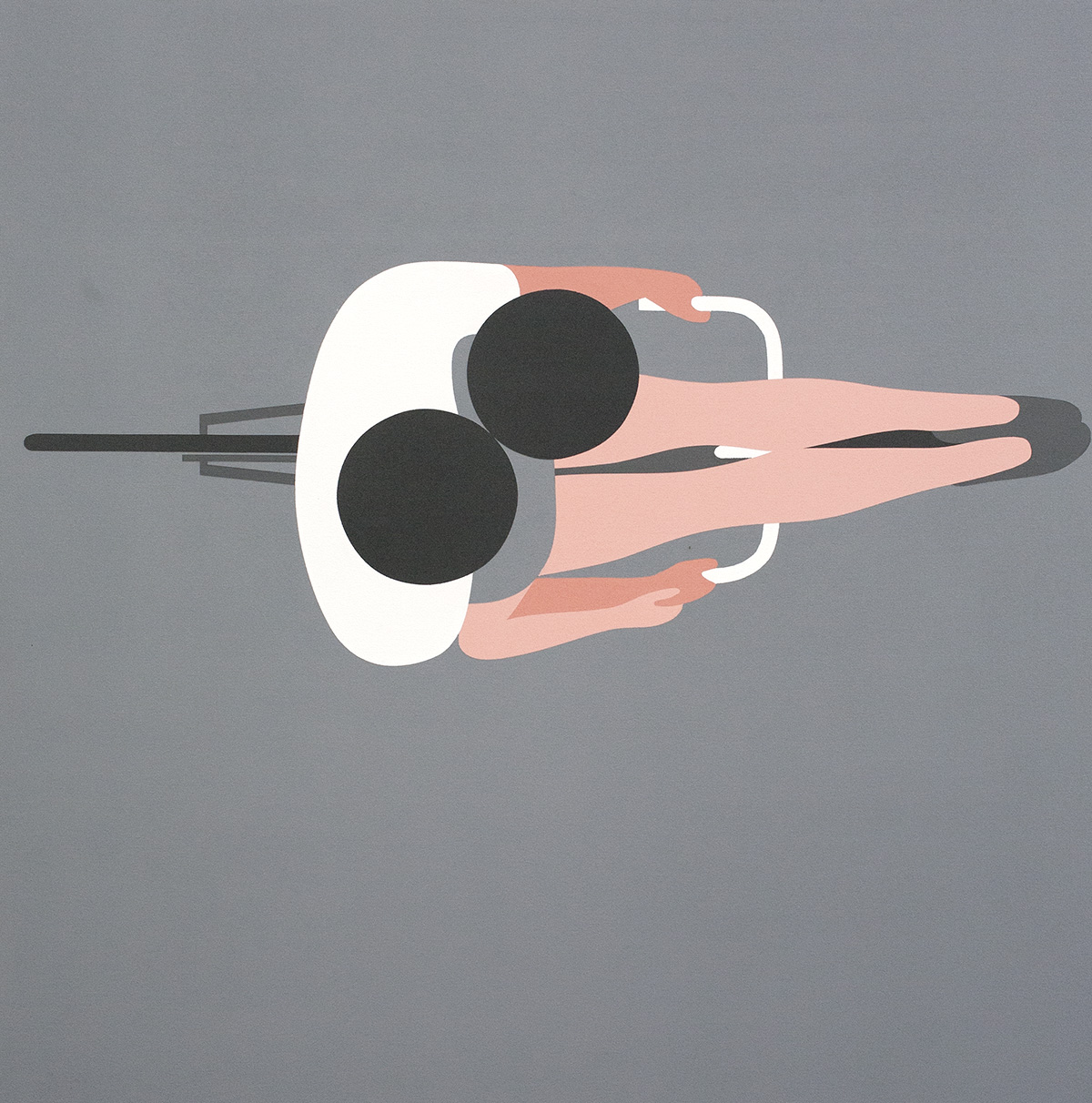2019 AIGA Medalist: Geoff McFetridge
Recognized for deftly relating design to time-based considerations—film titles, music videos, envisioning of AI—and vibrant sculptural forms, and for welcoming graphically-charged outsider/street subculture into the mainstream conversation.

Recognition
2019 AIGA Medal
Born
1971, Calgary, Alberta, Canada
Biography by Liv Siddall
March 25, 2019
Geoff McFetridge is one of the rare artists who has bridged the two peaks of art and commercial design successfully. There’s no trickery involved: it’s just that his attitude toward work, life, art, and making is all the same to him. He sees and approaches every creative act, and even day to day life, with the same attitude: everything is important, everything is process. The work he makes—across painting, animation, design, branding, drawing—is always imbued with a language he seeks not to teach us, but to draw out of us.
Since 1998, McFetridge has exhibited his paintings and drawings at a multitude of galleries all over the world, and his lengthy career shows no signs of abating. In 2004, he was part of the now-famous, era-defining Beautiful Losers show that kick-started the careers of the artists involved—much like the Freeze show in 1988 did for the Young British Artists (YBAs). Alongside his painting, McFetridge has created design and art direction work under the pseudonym of Champion Studio for a multitude of different brands including Mini, Patagonia, Becks, Nike, GAP, MTV, Vans, and Stussy; musicians such as OK GO, Death Cab for Cutie, Jack Johnson, or The Whitest Boy Alive, for whom he created branding, album artwork, and music videos; and publications such as The Paris Review,The New York Times, and The New Yorker. He has also created large pieces of installation work for The Standard Hotel; the Walker Art Center; the exterior of Warby Parker in Venice, California; and the Beverly Center. In 2016, he won the Cooper Hewitt, Smithsonian Design Museum National Design Award for Communication Design and since 2001, McFetridge has picked up no less than seven D&AD Awards for his work.
That’s barely the half of it. Not many other designers or artists could present such a varied portfolio. But so much of McFetridge’s work is tied together that what he turns his pen or brush to doesn’t seem to matter; it is always created with integrity, style, and purpose. No matter how diverse his projects, they can always be recognized as one of his. It’s almost as if McFetridge’s portfolio is like a bunch of different types of clothing hanging out to dry in the sunshine, every piece tied together by the same piece of string.

10 Dots (2012). Image courtesy Geoff McFetridge.

A Proposal For A Glass of Water (2012). Image courtesy Geoff McFetridge.

2 x 2 (2012). Image courtesy Geoff McFetridge.
McFetridge’s innate ability to use imagery as a vessel through which to speak to us can be traced back to his first few years as a designer. After finishing up at school in the late 1980s, McFetridge went to art school in his Canadian hometown of Calgary. He then attended grad school at California Institute of the Arts (CalArts) where he studied commercial arts. But making art for art’s sake seemed daunting to him then, and he was attracted to design. Before setting up his current studio in Los Angeles, it was skateboarding and the musically and aesthetically fertile scene that comes with it that catalyzed his future work. He began designing boards for Girl and Chocolate. It was the era in which the self-explanatory, instantly-gratifying logo reigned supreme, and McFetridge was struck by the energy they gave off and the clear language with which they spoke. “With logos you have no choice, they’ve been given to you, spoken to you, and that is the language of commerce that is speaking to you all the time.”
“It felt like creating inward-looking work was kind of the antithesis of that,” McFetridge remembers. So McFetridge began looking inwards, relying on his ability to travel deep into his mind tobring ideas back like loot. These ideas would become drawings that would then be translated into paintings that communicated his internally-constructed ideas as clearly as a logo ever could. His mysterious skill at looking at the world and really seeing it comes from a lifetime dedicated to drawing. When McFetridge was growing up, both his parents worked full-time, and like many kids, he would draw for entertainment as much as escapism. Even now, in his mid 40s, he can’t help himself.
McFetridge sees and approaches every creative act, and even day to day life, with the same attitude: everything is important, everything is process.
His compulsion to draw the same thing again and again doesn't seem to be abating any time soon. He doesn’t quite understand this habit, but he knows there’s definitely something in it. Particularly, the “cognitive connection, from the tip of the pencil to your eye and your mind.” It’s a connection most of us rarely, if ever, engage. It’s practical, too, as he sees his draftsmanship as a shortcut rather than the scenic route. “If you’re drawing the same things, it’s sort of a shortcut in the creative process; so instead of spending time thinking about what I’m going to draw, I get quickly to what’s happening and get into an arithmetic of building an image,” McFetridge explains. “The images, like the people, are just like numbers, and I’m arranging them and building these equations.”
Now McFetridge’s work can be found all over the globe in the form of paintings, ceramics, drawings, murals, and zines. For nearly 20 years, he has collaborated with Benjamin Sommerhalder, the publisher of Nieves, on beautiful and collectable small publications of his work. “I remember the excitement holding a publication in my hands for the first time. It was a dream come true,” Sommerhalder recalls. “I love Geoff’s line and that each drawing is so full of ideas and still so reduced to its very essence.”
Sommerhalder’s description of reducing something to its essence is often the reason why people cite McFetridge’s work as being particularly special to them, especially when it comes to his paintings. Typically, these are large canvases that depict oft-overlooked moments in life, lit up by McFetridge as if with a spotlight. Bird’s-eye views of cyclists, a man walking upstairs in bright sunlight, the motion of a beach towel, the shape of a body as it lies in the fetal position, the way human legs hang when astride a horse. Nothing really life-changing, but at the same time, absolutely nothing inconsequential.
McFetridge’s never even had an agent, and his only helper when prepping for a show is his studio manager, fellow artist Jesse Sanes. “I’ve decided the way my studio operates is essential to what I make,” McFetridge says. “There’s not a separation, it’s not like what I make and the way I do business. The way I operate and what I make is all one thing. So it’s like, what’s a way to run a studio in a way that’s as unique as what I’m making?”
“I love Geoff’s line—and that each drawing is so full of ideas and still so reduced to its very essence.” —Benjamin Sommerhalder
McFetridge’s current two-story studio in Glendale, California, is unique. It’s the kind of airy, haphazard, and naturally creative space that Pinterest users dream of. Similarly, McFetridge’s wholesome, healthy attitude to creativity and the work/play balance is whispered about in over-egged rumors, as if he were the Jay Gatsby of the overly-aspirational creative world. “Is it true he paints in the morning then cycles all afternoon?” Or, “I heard he surfs every single day,” say others. “Someone told me he approaches fixing his bike the same way that he paints a mural,” has been mentioned. Unlike many designers who have moved from agency to agency or office to office, McFetridge prefers to reside in his own space, with just Sanes, and run Champion Studio and his painting work in a freelance capacity.
McFetridge uses his method to create work for an ever-expanding constellation of clients that span across editorial, commercial, film, animation, and apparel. In 1999, McFetridge created the dreamy teenage-diary bubble writing in the title sequence for Sofia Coppola’s unforgettable adaptation of Jeffrey Eugenides’ The Virgin Suicides. Later, he was invited by his friend, director Spike Jonze, to create the futuristic-yet-slightly retro interfaces for his Oscar-nominated sci-fi romance blockbuster Her.
The most striking aspect of his portfolio is that his choice of project and client is based on his integrity in that every client he’s worked for, or every collaborator he’s partnered with, fits his ideologies, his interests, and his taste. He’s humble about it, too. When asked about how he felt about doing the spot illustrations for The New Yorker (twice) he said he could barely remember drawing them because he “blacked out” with excitement.
Aviva Michaelov, the design director of The New Yorker, cites McFetridge as being one of the magazine’s favorite artists. “Geoff’s wit comes through his art, which he delivers so concisely,” Michaelov says. “There’s always an element of surprise: an angle you hadn't yet considered, or a delightfully surreal relationship between a human and an object.” This sentiment was backed up by Bill Powers, an old friend of McFetridge’s and owner of New York’s Half Gallery. When asked what drew him to McFetridge’s paintings, Powers said he was drawn to the “humor and simple elegance of his work.”
It’s striking how popular McFetridge is. People are excited to speak about him and to have the chance to gush about his work or, more often than not, just McFetridge himself. People seem to harbor friendly, envious feelings toward his attitude to life. “To be able to create this type of work is very rare, and Geoff should be applauded and celebrated for it,” says Jesper Elg, director of Copenhagen’s V1 Gallery, who has worked closely with McFetridge since 2006 and represented him since 2014. “And to make things even more annoying, he is also a gentleman, a very loving and patient father, a fine human being, a good skateboarder, skier, and trail runner.”
McFetridge seems to really understand how to live, to make the most of life, and to see the world. His art is a product of his onward trek to explore the far corners of his mind in a bid to make sense of our relationship with the earth around us. And he brings it back and shows it to us in a way we can understand, appreciate, and find extraordinarily beautiful. As an old friend, Joel Mesler, described how McFetridge’s images “seem to be the fabric of our human condition” and “are so easy to connect with because at some point we have all felt that way or been in the moments he describes.”
McFetridge sees his extraordinary output as just not wanting to waste time because the world’s a beautiful place, and there’s a lot of work to do to try and get that down on paper. “I really value my time… it makes you realize when something is the right thing to be doing,” he says. “You watch how water flows through the mountains, and it’ll go to the lowest point, it’ll cut through rock, it always finds a way. I think I’m awake to that feeling in what I make.”
Sources
Alagiah, Matt. “‘I’m a believer in form’: Geoff McFetridge on his new book of introspective drawings.” It’s Nice That, December 11, 2018. https://www.itsnicethat.com/articles/geoff-mcfetridge-coming-back-is-half-the-trip-publication-111218
Anderson, Margaret. “How Geoff McFetridge Separates Art from Design in His L.A. Studio.” AIGA Eye on Design, June 16, 2017. https://eyeondesign.aiga.org/how-geoff-mcfetridge-separates-art-from-design-in-his-l-a-studio/.
Art of the Title. “The Virgin Suicides (1999).” Art of the Title. http://www.artofthetitle.com/title/the-virgin-suicides/
Butler, Andy. "Interview with artist geoff mcfetridge.” Designboom, January 30, 2014. https://www.designboom.com/art/interview-with-artist-geoff-mcfetridge-01-30-2014/.
Cooper Hewitt National Design Awards. “Geoff McFetridge. on the National Design Awards Gallery.” Cooper Hewitt National Design Awards, 2016. http://ndagallery.cooperhewitt.org/mcfetridge.
Essmaker, Tina. “Geoff McFetridge.” The Great Discontent, January 24, 2017. https://thegreatdiscontent.com/interview/geoff-mcfetridge.
Fold Magazine. “Everything Starts With a Drawing - Geoff McFetridge.” https://www.foldmagazine.com/everything-starts-drawing-geoff-mcfetridge.
Joshua Liner Gallery. “Geoff Mcfetridge at The Beverly Center.” Posted September 20, 2016. http://joshualinergallery.com/gallery/newsarticle/geoff_mcfetridge_at_the_beverly_center/.
Siddall, Liv. “Going Without Knowing: Geoff McFetridge on his leisure-centric approach to creativity.” It’s Nice That, June 2, 2015. https://www.itsnicethat.com/features/going-without-knowing-geoff-mcfetridge-on-his-leisure-centric-approach-to-creativity.
Walker, Alissa. “An Interview with Geoff McFetridge on the Interfaces from Her.” Gizmodo, January 2, 2014. https://gizmodo.com/an-interview-with-geoff-mcfetridge-on-the-interfaces-fr-1526237090.